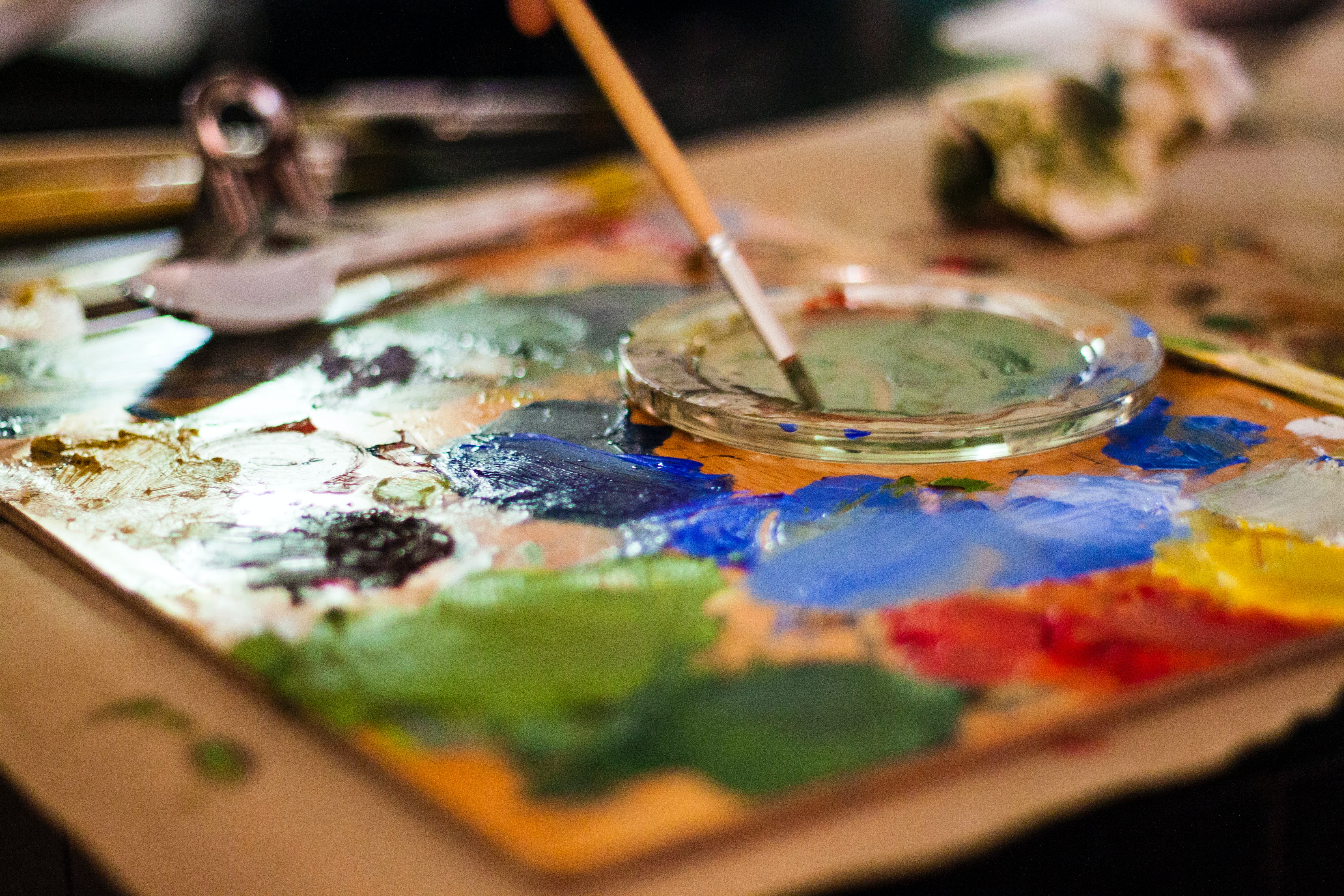How To Paint On Wood With Acrylics

Acrylic paint, known for its versatility, is a popular choice among artists for various surfaces, including wood. The combination of textures and visual appeal in painting on wood with acrylics results in eye-catching artwork. This medium encourages artists to explore different techniques, colours, and styles while appreciating the natural charm of wood. Both seasoned artists and beginners can find painting on wood with acrylics an engaging and fulfilling creative experience. To achieve the best results, it's essential to consider specific factors when working with acrylic paint on wood.
Do:
- Apply a primer: Using a primer on the wood surface prior to painting enhances acrylic paint adhesion and ensures more uniform coverage.
- Smooth the surface: By sanding the wood surface, you can improve paint adhesion and achieve a finer finish.
- Opt for thin, multiple layers: Applying several thin coats of acrylic paint, rather than one thick layer, and allowing each coat to dry thoroughly before the next application will yield optimal results.
Don't:
- Apply acrylic paint directly on unprepared wood: Without proper preparation, acrylic paint may not adhere well to the surface, leading to chipping and peeling.
- Use water-based acrylics on oil-rich woods: Water-based acrylic paints may struggle to bond with oily woods like teak. In these cases, opt for oil-based acrylic paints for better adhesion.
Choosing the Wood to Paint On
When painting with acrylics on wood, it's crucial to choose the right type of wood. Different woods react differently to paint, with hardwoods being more porous and absorbing paint easily, while softwoods offer a smoother surface and need fewer coats for full coverage. Plywood and particle board are also popular choices, but thorough sanding is essential to ensure proper paint adhesion.
Selecting a Suitable Type of Wood
Plywood - Plywood is an affordable and versatile option for painting with acrylics. Choose a higher-grade plywood with minimal knots and imperfections for a smooth surface.
MDF (Medium Density Fibreboard) - MDF is another cost-effective option. It has a smooth surface and is less prone to warping compared to plywood.
Hardwoods - Hardwoods like oak, maple, and birch provide a durable and high-quality surface for painting. However, they can be more expensive and may require additional preparation.
Basswood - Basswood is a popular choice among artists due to its fine, even grain and light colour. It's easy to work with and provides a good surface for acrylic paints.
Preparing the Wood Surface
To ensure successful acrylic painting on wood, surface preparation is vital. Begin by sanding the wood for a smooth finish, and, on rougher surfaces, apply a primer before painting.
Cleaning
Clean the wood surface with a damp cloth to remove any dust or dirt. Allow it to dry completely before moving on to the next step.
Sanding
Sand the surface with fine-grit sandpaper (around 220 grit) to create a smooth and even surface. Sand in the direction of the wood grain, and wipe away any dust with a damp cloth.
Applying Primer
Apply a layer of primer, such as gesso or acrylic primer, to seal the wood and prevent the paint from soaking into the fibres. This will also help the colours appear more vibrant on the finished piece. Allow the primer to dry according to the manufacturer's instructions.
Applying Additional Coats
If necessary, apply additional coats of primer, sanding lightly between each coat for a smoother surface. Once you are satisfied with the surface, you can begin painting with acrylics.
Remember to use thin coats of paint and build up layers for the best results. Enjoy the process of creating your artwork on wood!
Gathering Supplies
Gathering supplies is an important step in any creative endeavour. When it comes to painting, you'll need a variety of essential materials
Acrylic Paints
Choose high-quality acrylic paints that offer good coverage and a wide range of colours to bring your artwork to life.
Brushes and Painting Tools
Select an assortment of brushes in various sizes and shapes, as well as painting tools like palette knives and sponges for different techniques and textures.
Sandpaper, Primer, and Sealant
Prepare the wood surface with fine-grit sandpaper and apply a primer to ensure proper paint adhesion. After completing your artwork, use a sealant to protect and preserve the painting.
Preparing the Wood Surface
Preparing the wood surface is an essential step before starting any wood-based project. It involves ensuring that the wood is clean, smooth, and ready for further treatment or finishing.
Sanding the Wood
Use fine-grit sandpaper (around 220 grit) to create a smooth and even surface. Sand in the direction of the wood grain.
Wiping Down the Surface
Clean the wood surface with a damp cloth to remove any dust or dirt. Allow it to dry completely before moving on to the next step.
Applying a Coat of Primer or Gesso
To ensure acrylic paint adheres to wood, apply a primer or use an all-in-one acrylic paint and primer. Follow the product label instructions for application.
After priming, keep the following tips in mind while painting:
● Apply thin coats of paint to avoid bubbling and ensure even coverage.
● Let each coat dry fully before adding another layer.
● If your acrylic paint isn't self-levelling, sand between coats for a smooth finish.
Applying the Acrylic Paint
After the primer dries, begin painting with high-quality acrylic paints to ensure proper adhesion and prevent peeling or chipping. Recommended brands include Matisse, Winsor & Newton, Reeves, and Liquitex.
Work with thin paint layers and build up the colour gradually to avoid cracking or flaking. Allow each layer to dry completely before applying the next colour.
Painting Techniques
Painting techniques encompass a wide range of methods used to apply paint to a surface, creating different effects and textures.
Applying Base Layers
Start by laying down a base layer of paint, which will serve as the foundation for your artwork. This helps to establish the overall colour scheme and mood of your piece.
Building Up Layers and Blending Colours
Gradually build up layers of paint, allowing each one to dry before applying the next. Use blending techniques to create smooth transitions between colours and add depth to your work.
Using Different Brush Strokes and Techniques
Experiment with various brushstrokes, brushes, and painting tools to achieve different textures and effects. This can enhance the visual interest of your artwork and give it a unique, personal touch.
Finishing Your Artwork
Finishing your artwork is the final step that brings your creation to completion. It involves various processes to enhance and protect the artwork.
Letting the Paint Dry
Allow the paint to dry completely, following the manufacturer's recommended drying time, to ensure the colours and textures are set properly.
Applying a Protective Sealant or Varnish
To achieve the best results when painting with acrylics on wood, it's essential to follow a few key steps. Ensure you use a primer, sand the surface, and apply multiple thin coats for optimal coverage. Once satisfied with your artwork, protect it using an acrylic sealant specifically designed for use with acrylic paint. By adhering to these guidelines, you'll create stunning and durable pieces that showcase your artistic talents.
Displaying or Storing Your Artwork
Choose how to display your finished piece, whether on a wall or in a frame. If storing, place it in a secure and dry location to prevent any damage or deterioration.
Tips and Tricks for Painting on Wood
Here is a list of tips and tricks for painting on wood:
- Prepare the wood surface: Clean the wood thoroughly and sand it to create a smooth and even base for painting. Remove any dust or debris before starting.
- Use a primer: Apply a primer specifically designed for wood to enhance paint adhesion and create a stable surface for your artwork.
- Choose the right paint: Select high-quality acrylic or oil-based paints suitable for wood surfaces. Consider the type of finish you want to achieve and choose the appropriate paint accordingly.
- Thin layers: Apply paint in thin layers rather than thick coats. This helps prevent cracking and ensures better adhesion to the wood.
- Experiment with brush techniques: Explore different brush strokes and techniques to create interesting textures and effects on the wood surface. Try dry brushing, stippling, or blending to add depth and dimension.
- Consider a distressed look: If you desire a weathered or distressed appearance, try sanding the painted surface lightly or use a dry brush technique to create a worn effect.
- Seal the artwork: Once the paint is completely dry, protect your artwork by applying a varnish or topcoat. This will preserve the colours and provide a protective barrier against moisture and UV damage.
- Handle with care: Wood is susceptible to scratches and chipping. Be mindful of how you handle and store your painted wood pieces to ensure their longevity.
Remember to practice and experiment with different techniques to develop your own style and achieve the desired results when painting on wood.
In conclusion, acrylic paint offers remarkable versatility when it comes to painting on wood, allowing artists to create stunning and enduring masterpieces. By embracing this medium and encouraging creativity and experimentation, artists can continuously expand their skill set and push the boundaries of their work. As you explore new techniques, mix mediums, and incorporate unique design elements, you'll unlock a world of artistic possibilities and produce truly captivating pieces.
FAQ - Painting on Wood with Acrylic Paint
Q: Can you paint on wood with acrylic paint?
A: Yes, acrylic paint is suitable for painting on wood surfaces. It adheres well to wood and provides vibrant colours and a durable finish.
Q: Do I need to prepare the wood surface before painting with acrylic paint?
A: Yes, preparing the wood surface is essential for successful painting. Clean the wood to remove any dirt or debris, and sand it lightly to create a smooth surface. Applying a primer designed for wood can also help improve paint adhesion.
Q: What type of acrylic paint should I use for painting on wood?
A: Use acrylic paints that are specifically formulated for wood surfaces. These paints have better adhesion and durability compared to regular acrylic paints. Look for paints labelled as "acrylic wood paint" or "acrylic craft paint."
Q: Do I need to seal or protect the painted wood surface?
A: While acrylic paint dries to a durable finish, it's advisable to protect your artwork by applying a clear varnish or topcoat. This helps to seal the paint and provides added protection against moisture, UV rays, and general wear and tear.
Q: Can I paint on both treated and untreated wood?
A: Acrylic paint can be applied to both treated and untreated wood surfaces. However, keep in mind that treated wood may have a smoother or sealed surface, which can affect paint adhesion. It's recommended to sand the surface lightly or use a primer to ensure proper adhesion.
